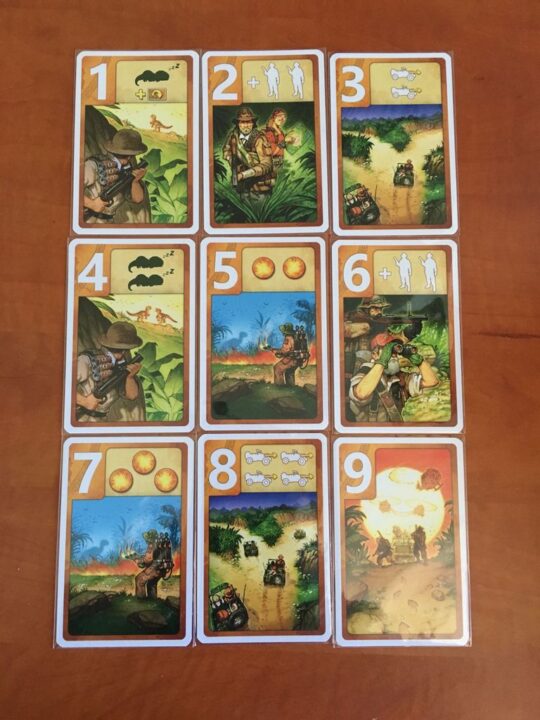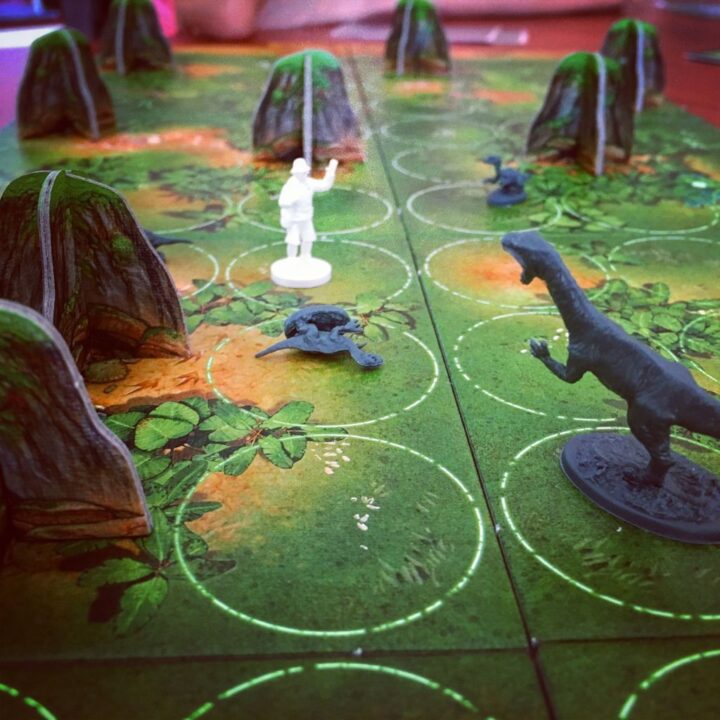Overview
Welcome to my latest board game review where we delve into the land of dinosaurs and scientists with Raptor. This strategic game captures players’ imaginations, but it’s in its clever design that truly shines. Join me as we explore the asymmetry of player powers, the intricacies of strategic choices, and the thrilling interaction and balance that Raptor offers. Is this a game worthy of gracing your table? Let’s find out together.
How It Plays
Setting Up
To set up a game of Raptor, you must decide who will take on the role of the raptors and who will lead the team of scientists. The board is assembled with five tiles making up the island. Each player receives cards specific to their side, and the raptors’ miniature figures are placed alongside their nest in the center of the island while scientists are placed at designated entry points along the edge of the playing area.
Gameplay
In Raptor, players simultaneously choose and reveal action cards. The difference in values determines player actions, with the lower value activating that special ability and the higher value granting more standard actions. Raptors aim to evade scientists and rescue their babies, while scientists work to capture these clever dinosaurs or sedate them for science.
Winning the Game
An interesting asymmetry sets the stage for victory. For the scientist team, they must capture three raptor babies or sedate the mother raptor to win. Conversely, the raptor player wins by either freeing three baby raptors from the board or eliminating all scientists, ensuring a thrilling dash to fulfill these distinctive objectives.
The rich asymmetry pairs with brisk gameplay, setting the stage for the strategic depth and engrossing player interaction Raptor has to offer in my review to come.
Want to know more? Read our extensive strategy guide for Raptor.
Asymmetry: The Raptor Review Insight
One of the most gripping elements I’ve discovered is thriving in the asymmetrical power landscape of Raptor. This establishes a captivating cat-and-mouse dynamic that’s palpable from the get-go. During my sessions, I’ve relished the opportunity to embody either the cunning scientists, operated by a friend aiming to capture my offspring or the protective raptor momma, where I fiercely deflect encroaching threats.
Reflecting Unique Strategies
Interestingly, the asymmetry compels you to adopt an evolving approach—no gameplay is identical. As the raptor, I frequently relied on ambush tactics, hiding in the brush, waiting for the perfect moment. Meanwhile, scientists demanded strategic foresight, managing resources carefully, an aspect my analytical playgroup found exceptionally engaging—the ongoing mind games are a riot!
Imbalanced Power Tango
Despite different abilities and objectives, Raptor remains stunningly balanced. Transitioning roles between games showcased game design finesse; both sides presented unique yet aliquant hurdles to leap over. Inevitably, midst our exhilarated cheers and groans, it’s this rejoiceful asymmetry weaving our most cherished memories, time after time.
Having explored the asymmetry of player powers, we venture next into the labyrinth of thought—it’s now time to dissect the depth of strategy choices.

The Tactical Terrain of Raptor
When immersed in my ‘Raptor Review’ playthroughs, I marveled at the Depth of Strategy Choices inherent in the gameplay. As a scientist, you’re placing traps and sedatives, cleverly anticipating the raptor’s moves. Switching to the raptor mother’s perspective offered a starkly different approach. Her strategy is guided by raw instincts to protect and outmaneuver her opponents. Every session painted a tactical masterpiece with its unique strategic needs.
Varied Approaches
Adaptability is key; there’s no singular path to victory. The topography of the board presents numerous paths and strategies, forcing choosy decisions at every turn. I revel in such diversity of playstyle from game to game.
Strategic Layers
I’ve seen some cunning moves playing Raptor; clever card plays change outcomes in unpredictable ways and up the tactical ante.
Navigating the next section: let’s dissect how these strategies interact and preserve the game balance.

Nailing Interaction and Balance
The strategic weights tip ingeniously in Raptor, leading to my closing thoughts on recommendation.
Critical Encounters
Regarding interaction, every move in Raptor feels incredibly consequential. This one time, a cunning pincer move bore the unmistakable chess-like finesse, only achievable through a game with deeply integrated player interaction. Continuously, we found ourselves locked in a tense dance of bluff and counterbluff, the game constantly teetering with suspense. Memories like these accentuate the pivotal exchanges unique to this gaming experience.
Meticulously Balanced
Balance, vital in any asymmetric game, can possibly break them. Remarkably, Raptor dysfunctionally delights; each side’s strengths and weaknesses harmonically play the balancing act—never feeling overly dominant. For that, my Raptor Review endorsement rings without hesitation.

Conclusion
Wrapping up this review of Raptor, we’re left reflecting on a game rich with asymmetrical challenges, deep strategic potential, and a beautiful harmony of interaction and balance. If you relish a board game that funds both sides of your brain, where every decision feels purposeful and every match plays out differently, Raptor definitely should sneak its way onto your shelf. Affordable, relatively quick, yet teeming with replayability, it carves out a niche that few games can claim. For those who brave the island, the reward is a gaming experience that captivates and thrills – truly, a game that stands triumphantly at the pinnacle of its genre.









